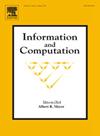Composing bridges
IF 1
4区 计算机科学
Q3 COMPUTER SCIENCE, THEORY & METHODS
引用次数: 0
Abstract
The present work builds on previous investigations of the authors (and their collaborators) regarding bridges, a certain type of morphisms between encryption schemes, making a step forward in developing a (category theory) language for studying relations between encryption schemes. Here we analyse the conditions under which bridges can be performed sequentially, formalizing the notion of composability. One of our results gives a sufficient condition for a pair of bridges to be composable. We illustrate that composing two bridges, each independently satisfying a previously established IND-CPA security definition, can actually lead to an insecure bridge. Our main result gives a sufficient condition that a pair of secure composable bridges should satisfy in order for their composition to be a secure bridge. We also introduce the concept of a complete bridge and show that it is connected to the notion of Fully composable Homomorphic Encryption (FcHE), recently considered by Micciancio. Moreover, we show that a result of Micciancio which gives a construction of FcHE schemes can be phrased in the language of complete bridges, where his insights can be formalized in a greater generality.
组合桥梁
目前的工作建立在作者(和他们的合作者)之前关于桥的研究基础上,桥是加密方案之间的某种类型的态射,在开发用于研究加密方案之间关系的(范畴论)语言方面向前迈出了一步。在这里,我们分析了可以依次执行桥接的条件,形式化了可组合性的概念。我们的一个结果给出了一对桥是可组合的充分条件。我们举例说明,组成两个桥,每个桥都独立地满足先前建立的IND-CPA安全定义,实际上可能导致不安全的桥。我们的主要结果给出了一对安全可组合桥要构成安全可组合桥必须满足的充分条件。我们还介绍了完全桥的概念,并表明它与Micciancio最近考虑的完全可组合同态加密(FcHE)的概念相关联。此外,我们表明,Micciancio的结果给出了FcHE方案的构造,可以用完整桥梁的语言来表达,他的见解可以更普遍地形式化。
本文章由计算机程序翻译,如有差异,请以英文原文为准。
求助全文
约1分钟内获得全文
求助全文
来源期刊

Information and Computation
工程技术-计算机:理论方法
CiteScore
2.30
自引率
0.00%
发文量
119
审稿时长
140 days
期刊介绍:
Information and Computation welcomes original papers in all areas of theoretical computer science and computational applications of information theory. Survey articles of exceptional quality will also be considered. Particularly welcome are papers contributing new results in active theoretical areas such as
-Biological computation and computational biology-
Computational complexity-
Computer theorem-proving-
Concurrency and distributed process theory-
Cryptographic theory-
Data base theory-
Decision problems in logic-
Design and analysis of algorithms-
Discrete optimization and mathematical programming-
Inductive inference and learning theory-
Logic & constraint programming-
Program verification & model checking-
Probabilistic & Quantum computation-
Semantics of programming languages-
Symbolic computation, lambda calculus, and rewriting systems-
Types and typechecking
 求助内容:
求助内容: 应助结果提醒方式:
应助结果提醒方式:


